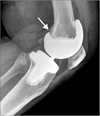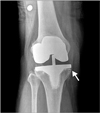Abstract
Purpose
The purpose of this study was to evaluate the results of high-flexion total knee arthroplasty.
Materials and Methods
We evaluated 355 patients (372 cases) who underwent total knee arthroplasty using high-flexion implants from January 2005 to December 2011. The patients included 36 men and 336 women with a mean age of 70.6 (52-88 years) years. Average follow-up duration was 59 months (36-77 months) months. Three types of high flexion implants were used in this study. We performed preoperative assessment and last follow-up clinical evaluation was performed using range of motion (ROM), knee score and function score according to the knee society clinical rating system and complications. Radiologic evaluation was performed using plain radiographs to evaluate loosening or osteolysis.
Results
The mean ROM increased from 114.9° preoperatively to 127.0° at the final follow-up. The average knee score improved from 60.5 points preoperatively to 90.9 points at final follow-up and knee function score improved from 49.0 to 84.4 points. The clinical results were improved in each type of implants. A radiolucent line was detected in 2 cases in the Sigma rotating platform flexion group and patellar tendon rupture occurred in 1 case in the NexGex legacy posterior-stabilized-flex group. Infection occurred in 2 cases after 2 and 5 years postoperatively in the Scorpio non-restrictive geometry group and were treated with revision arthroplasty. No significant loosening was observed.
Figures and Tables
 | Figure 1A lateral radiograph of the left knee of a 62-year-old female who underwent total knee arthroplasty using Sigma rotating platform flexion implants postoperatively 1 year. A radiolucent line was observed in the posterior femoral condyle (arrow). |
 | Figure 2An antero-posterior radiograph of the right knee of a 66-yearold female who underwent total knee arthroplasty using Sigma rotating platform flexion implants postoperatively 1 year. A radiolucent line was observed in the medial tibia condyle (arrow). |
 | Figure 3Antero-posterior and lateral radiographs of the right knee of a 77-year-old female underwent total knee arthroplasty using NexGen legacy posterior-stabilized-flex implants postoperatively 1 month. An avulsion fracture of the patellar tendon was detected as a complication in a lateral radiograph (arrow). |
References
1. Lizaur A, Marco L, Cebrian R. Preoperative factors influencing the range of movement after total knee arthroplasty for severe osteoarthritis. J Bone Joint Surg Br. 1997; 79:626–629.

2. Matsuda Y, Ishii Y, Noguchi H, Ishii R. Varus-valgus balance and range of movement after total knee arthroplasty. J Bone Joint Surg Br. 2005; 87:804–808.

3. Schurman DJ, Parker JN, Ornstein D. Total condylar knee replacement. A study of factors influencing range of motion as late as two years after arthroplasty. J Bone Joint Surg Am. 1985; 67:1006–1014.

4. Harvey IA, Barry K, Kirby SP, Johnson R, Elloy MA. Factors affecting the range of movement of total knee arthroplasty. J Bone Joint Surg Br. 1993; 75:950–955.

5. Tew M, Forster IW, Wallace WA. Effect of total knee arthroplasty on maximal flexion. Clin Orthop Relat Res. 1989; 247:168–174.

6. Luo SX, Su W, Zhao JM, Sha K, Wei QJ, Li XF. High-flexion vs conventional prostheses total knee arthroplasty: a metaanalysis. J Arthroplasty. 2011; 26:847–854.

7. Sumino T, Gadikota HR, Varadarajan KM, Kwon YM, Rubash HE, Li G. Do high flexion posterior stabilised total knee arthroplasty designs increase knee flexion? A meta analysis. Int Orthop. 2011; 35:1309–1319.

8. Huang HT, Su JY, Wang GJ. The early results of high-flex total knee arthroplasty: a minimum of 2 years of follow-up. J Arthroplasty. 2005; 20:674–679.

9. Yamazaki J, Ishigami S, Nagashima M, Yoshino S. Hy-Flex II total knee system and range of motion. Arch Orthop Trauma Surg. 2002; 122:156–160.

10. Kim TH, Lee DH, Bin SI. The NexGen LPS-flex to the knee prosthesis at a minimum of three years. J Bone Joint Surg Br. 2008; 90:1304–1310.

11. Lee BS, Kim JM, Lee SJ, et al. High-flexion total knee arthroplasty improves flexion of stiff knees. Knee Surg Sports Traumatol Arthrosc. 2011; 19:936–942.

12. Cho SD, Youm YS, Park KB. Three- to six-year follow-up results after high-flexion total knee arthroplasty: can we allow passive deep knee bending? Knee Surg Sports Traumatol Arthrosc. 2011; 19:899–903.

13. Han HS, Kang SB, Yoon KS. High incidence of loosening of the femoral component in legacy posterior stabilised-flex total knee replacement. J Bone Joint Surg Br. 2007; 89:1457–1461.

14. Bennett D, Hanratty B, Thompson N, Beverland D. Measurement of knee joint motion using digital imaging. Int Orthop. 2009; 33:1627–1631.

15. Ritter MA, Campbell ED. Effect of range of motion on the success of a total knee arthroplasty. J Arthroplasty. 1987; 2:95–97.

16. Jung KH, Cho SD, Ko SH, et al. Early results of primary high flex total knee arthroplasty. J Korean Knee Soc. 2005; 17:234–240.
17. Bin SI, Nam TS. Early results of high-flex total knee arthroplasty: comparison study at 1 year after surgery. Knee Surg Sports Traumatol Arthrosc. 2007; 15:350–355.
18. Yoon YS, Rah JH, Oh JR, Park HK, Ryu HY. Three years follow-up results of high-flex total knee arthroplasty. J Korean Knee Soc. 2007; 19:231–236.




 PDF
PDF ePub
ePub Citation
Citation Print
Print




 XML Download
XML Download